
Science Highlights
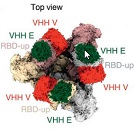
Structure-guided Nanobodies Block SARS-CoV-2 Infection – Contact: Ian A. Wilson (The Scripps Research Institute)
A potential treatment for COVID-19 patients is administering monoclonal antibodies, which can directly neutralize virus by interacting with its spike protein. Monoclonal antibodies are identified from patients or lab animals that have been exposed to the virus and manufactured in larger quantities to treat patients. One downside to monoclonal antibody treatment is the difficulty and expense in producing large quantities of these complex molecules. A pared-down alternative, a single-domain antibody called a nanobody, is easier and less expensive to produce. Nanobodies are also more stable and can potentially be administered through simple inhalation. A team of researchers are designing, characterizing, and improving nanobodies that are effective against the COVID-19 virus. Read more...
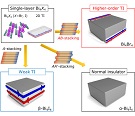
Designing a Higher-Order Topological Insulator Composed of Bismuth-Halide Chains – Contacts: Ryo Noguchi and Takeshi Kondo (University of Tokyo)
Spintronics is analogous to electronics, where an electron’s spin state is used to store information rather than, or in addition to, the charge. Potential uses for spintronics include storing information in electron spin, which is not disturbed by magnetic fields nor affects neighboring electrons like electron charge. Spintronics is considered one of the most promising emerging fields of research, having the potential to improve electronic devices’ speed, power use, and size. New materials are needed that are stable and achieve certain exotic quantum properties for spintronics to advance. A search for a suitable higher-order topological insulator (HOTI) is underway. Read more...
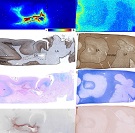
Iron Heterogeneity in Early Active Multiple Sclerosis Lesions – Contacts: Bogdan F. Popescu (University of Saskatchewan) and Claudia F. Lucchinetti (Mayo Clinic)
Evidence gathered over the last 40 years suggests that a diagnosis of multiple sclerosis (MS) includes different types of diseases, but MS is usually treated as one disease. MS is defined by a loss of myelin that surrounds the axons of neurons and inflammation, which leads to serious outcomes like paralysis, blindness, and bowel and bladder problems. Yet the causes and effective treatments of these symptoms may vary widely. Treatments that are developed to treat all MS patients have variable outcomes in individuals, and the underlying pathology of the disease also varies in different patients. Previous studies of MS lesions have revealed four distinct types (immunopatterns I, II, III and IV). Each pattern may respond better to a different treatment. Read more...
More User Research
New Ebolavirus Vaccine Design Seeks to Drive Stronger Antibody Defense
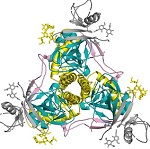
Excerpt from Scripps Press Release
Scientists at Scripps Research have unveiled a new Ebola virus vaccine design, which they say has several advantages over standard vaccine approaches for Ebola and related viruses that continue to threaten global health.
In the new design, described in a paper in Nature Communications, copies of the Ebola virus outer spike protein, known as the glycoprotein, are tethered to the surface of a spherical carrier particle. The resulting structure (with some of the data from SSRL) resembles the spherical appearance of common RNA viruses that infect humans—and is starkly different from the snake-like shape of the Ebola virus. Read more...
Implantable ‘Living Pharmacy’ could Control Body’s Sleep/Wake Cycles
Excerpt from Northwestern Now article by Amanda Morris
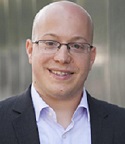
A team of researchers led by Jonathan Rivnay, Assistant Professor at Northwestern and long-time SSRL user, has signed a cooperative agreement with the Defense Advanced Research Projects Agency (DARPA) to develop a wireless, fully implantable device that will control the body’s circadian clock, halving the time it takes to recover from disrupted sleep/wake cycles.
The first phase of the highly interdisciplinary program will focus on developing the implant. The second phase, contingent on the first, will validate the device. If that milestone is met, then researchers will test the device in human trials, as part of the third phase. The full funding corresponds to $33 million over four-and-a-half years. Read more...
Tributes and Awards
Hal Tompkins Retires from SLAC
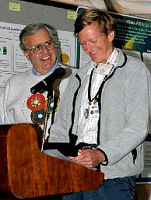
Hal Tompkins' many contributions to LCLS Operations over the past decade or so were mentioned in a SLAC Today news article to mark his recent retirement. His many years of service at SSRL before transferring to LCLS were also appreciated, so much so that he received the Farrel W. Lytle award. As noted in our October 2004 Headline News Hal received the award "For his instrumental role in optimizing the combined performance of the beam lines with the storage ring to the benefit of the user community. For his tireless efforts to ensure that users obtain the best possible data whether by solving optics, electronics, computer, or beam noise problems as they arise or by assisting users to exploit fully the SSRL instrumentation capabilities. For his attention to detail in scheduling users on the best instruments for their proposed experiments, his preparation of those instruments prior to the user arrival at SSRL, and the training and support which he provides to users during their visits." Hal started at SSRL soon after he earned his Ph.D. at Stanford. He became the x-ray group leader in 1993 and then moved to LCLS in 2010.
Hal, we hope retirement treats you well!
SLAC Affiliates among Ten Stanford faculty Members Elected to the American Academy of Arts and Sciences
Current and former SSRL users and SLAC affiliates Axel Brunger, Zhenan Bao, and Robert Byer, are among the ten Stanford faculty members out of 252 new members elected to the American Academy of Arts and Sciences, which honors exceptional scholars, leaders, artists and innovators engaged in advancing the public good. See Stanford News Article
Updates
SPEAR Lower Emittance Lattice
SSRL resumed operations for SPEAR3 users on May 12 with a new, 30% smaller emittance source lattice. The reduced source emittance yields a brighter x-ray beam and is the first of two SPEAR3 emittance reductions planned for 2021. The second emittance reduction will be delivered after the annual SSRL summer down.
User Operations
User experiments on most SSRL beam lines have been planned through the current run cycle, except for a few beam lines that are only projecting user beam time out a few weeks at a time. The beam line schedule has been posted online. Users can find and accept their beam time assignments through the user portal. See also: SSRL Experimental Run Schedule
COVID related limits to on-site activities will continue for some time, and discussions are underway regarding vaccination policies. Currently, we are only able to request site access for local users from Northern California, expanding to users from Southern California in June. Experiments for out-of-state users are being done remotely by beam line staff in coordination with users.
The current run ends August 1st when SSRL shuts down for maintenance/upgrades until October.
Announcements
Call for Award Nominations
Recognize outstanding achievements of your colleagues, postdocs, students (or yourself) by submitting nominations for the following awards by the posted deadlines. These awards will be presented at the SSRL/LCLS Users’ Conference planned as a virtual meeting from September 20-24, 2021. The recipients of the Klein and Spicer awards will be asked to present their research during the plenary session. Send nomination packages to knotts@slac.stanford.edu.
William E. and Diane M. Spicer Young Investigator Award -- Submit Nominations by JULY 1: The $1,000 Spicer Young Investigator Award honors the professional and personal contributions that William E. and Diane M. Spicer made to our community. Submit nomination packages including a letter summarizing the scientific contributions of the candidate as well as their CV and publications (supporting letters also encouraged).
Melvin P. Klein Scientific Development Award -- Submit Nominations by AUGUST 1: This $1,000 award honoring Mel Klein's many contributions recognizes research accomplishments of undergraduate/graduate students or postdoctoral fellows within three years of receiving their Ph.D. This award provides peer recognition and helps to promote dissemination of results based on work performed at SSRL. The nomination package should include the candidate’s CV, letters of recommendation from the advisor and colleagues, as well as an abstract written by the candidate describing the SSRL related experiments, scientific results, and plans to present the findings.
Farrel W. Lytle Award -- Submit Nominations by AUGUST 5: The $1,000 Lytle Award was established to promote technical or scientific accomplishments in synchrotron radiation-based science and to foster collaboration and efficient use of beam time at SSRL. SSRL users and staff are eligible to be nominated for the Lytle Award. Letters of nominations should include a summary of the individual's contributions and why they should be recognized through this award. Supporting letters are welcome.
Call for User Publications and Reminder to Acknowledge SSRL and Funding Agencies
Our multi-year facility review by DOE BES is coming up and publications are an important metric of productivity. To help us update our publications lists for 2016–2020 and beyond please take a few minutes to use our publications database search and submit form to see if your SSRL-related publications are included and add any that are missing.
Acknowledgement templates are provided on our website. A reminder - note that with the renewal of the SSRL Structural Molecular Biology Program, the NIH grant number to include has changed to P30GM133894.
Events
SSURF Webinar: ORCID - Connecting Research and Researchers, June 1, 2021, 2:00 pm ET - Registration
Remote Powder Diffraction Webinar, June 3, 2021, 10:00 am PDT - Registration

Powder diffraction is a commonly used technique by many of our users across scientific disciplines and a technique which we have focused on enabling through remote and mail-in capabilities. In order to demonstrate the new capabilities and to illustrate the types of science that remote technologies enable and simplify, we are organizing a workshop/webinar to give a virtual walkthrough of the remote or mail-in experimental process. This workshop/webinar will cover how to properly prepare samples for mail-in, how to remotely access the beamline control computers, how to remotely collect data including the use of a newly developed robotic sample changer, and go over new developments in data processing and analysis which are being standardized at SSRL material science scattering beamlines. Webinar website
Electron Microscopy-X International Symposium, June 7, 2021, 8:00–9:30 am (PDT) - Registration
Ultrafast X-ray Summer School (UXSS), June 14–18, 2021 - UXSS website
APS/IIT Virtual Summer XAFS School, August 1–4, 2021 - Announcement
SSRL/LCLS Users' Conference, September 20–24, 2021 — Save the Date
AVS 67th International Symposium, October 24–29, 2021, Charlotte, North Carolina - AVS67 website
User Research Administration
Proposal Deadlines
- Macromolecular Crystallography - July 1, 2021
- Xray/VUV - August 1, 2021
- COVID-19 related proposals for beam time at SSRL and microscope time at our CryoEM facility can be submitted at any time and will be reviewed expeditiously.
- CryoEM biology-related proposals for the S2C2 program are currently being reviewed on a monthly basis.
Submit beam time requests and proposals through the User Portal. Questions can be directed to the SSRL User Office or the CryoEM User Office
The Stanford Synchrotron Radiation Lightsource (SSRL) is a third-generation light source producing extremely bright x-rays for basic and applied research. SSRL attracts and supports scientists from around the world who use its state-of-the-art capabilities to make discoveries that benefit society. SSRL, a U.S. DOE Office of Science national user facility, is a Directorate of SLAC National Accelerator Laboratory, operated by Stanford University for the U.S. Department of Energy Office of Science. The SSRL Structural Molecular Biology Program is supported by the DOE Office of Biological and Environmental Research, and by the National Institutes of Health, National Institute of General Medical Sciences. For more information about SSRL science, operations and schedules, visit http://www-ssrl.slac.stanford.edu.
To unsubscribe from SSRL Headlines, just send an e-mail to listserv@slac.stanford.edu with "signoff ssrl-headlines" in the body.
To subscribe, send an e-mail to with "subscribe ssrl-headlines" in the body.
Questions? Comments? Contact Lisa Dunn




